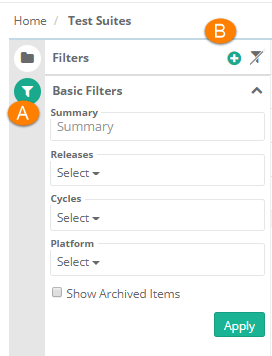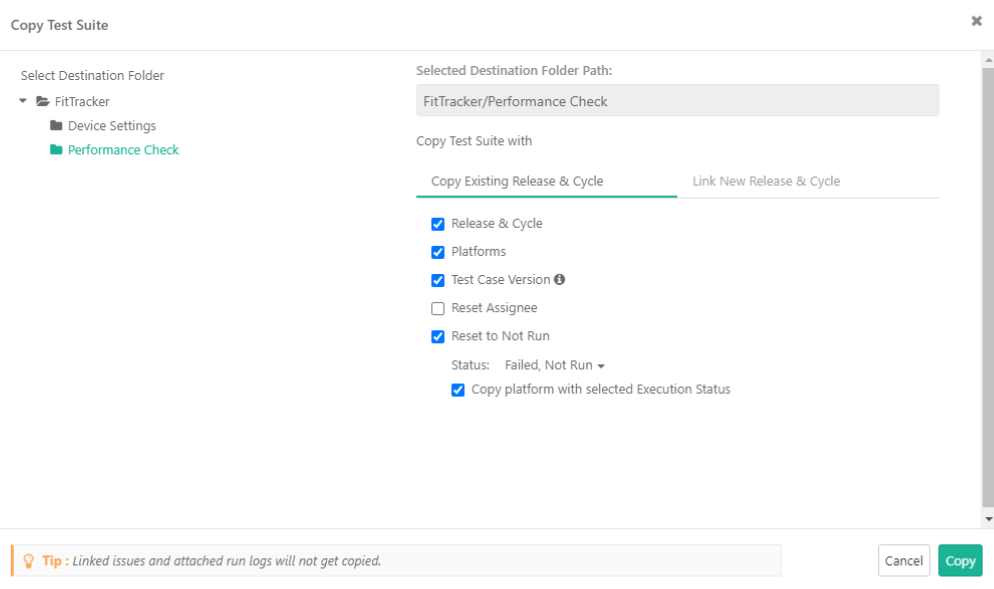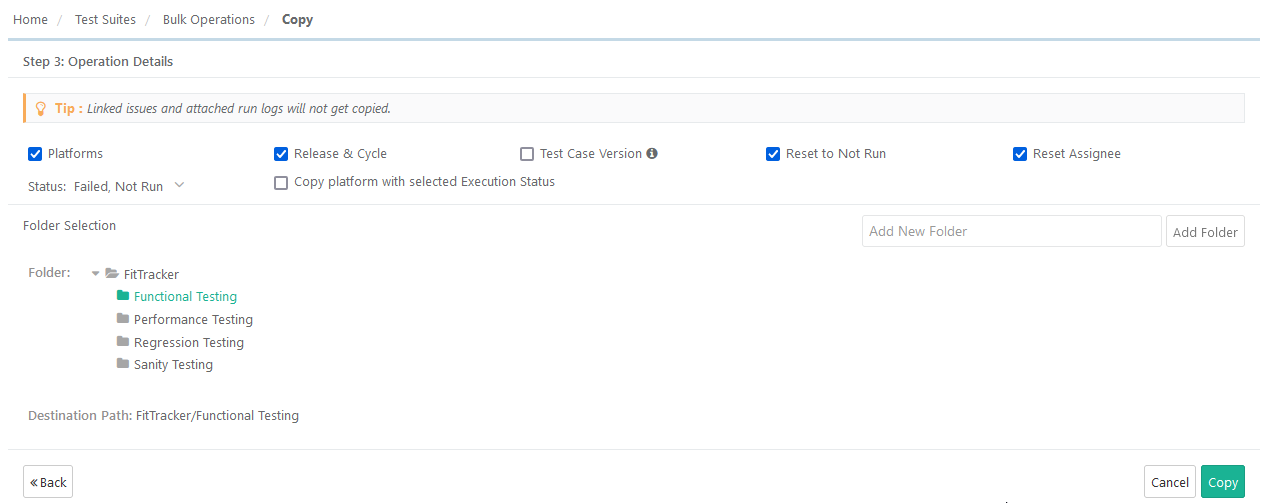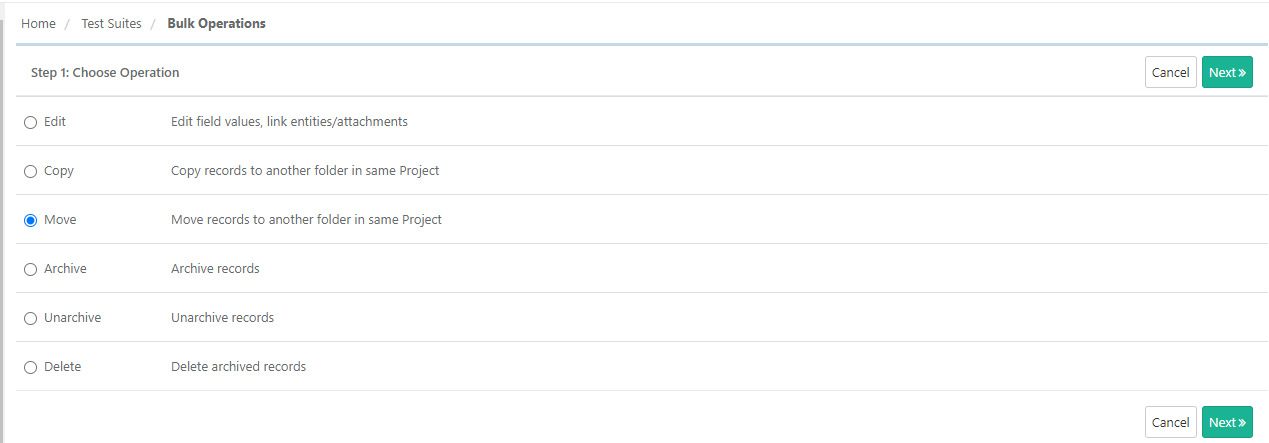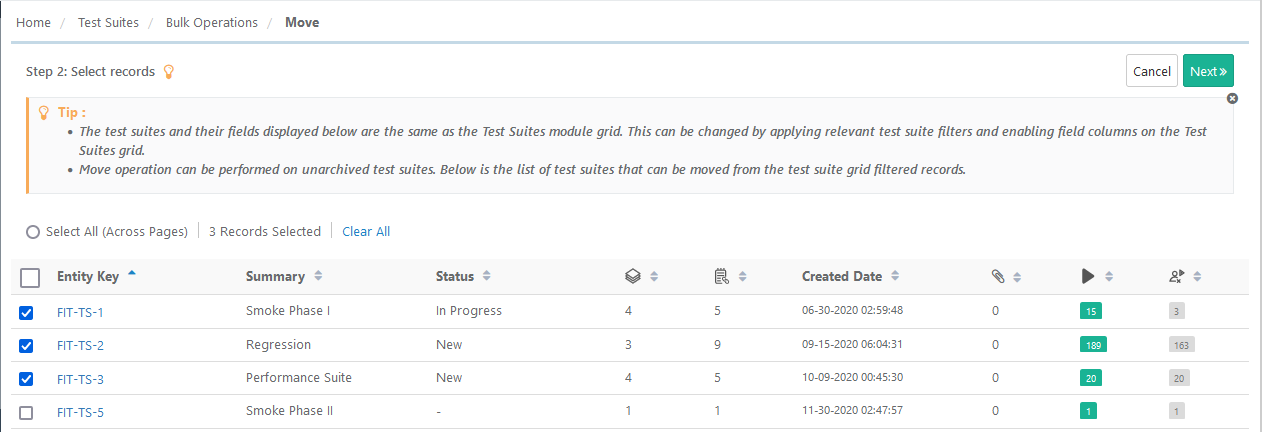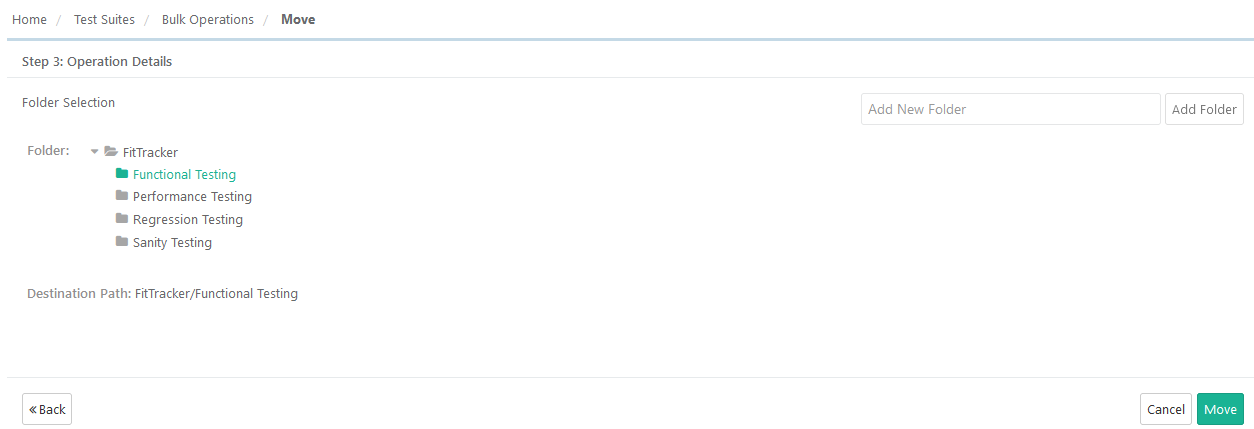| Table of Contents | ||
|---|---|---|
|
...
A test suite contains a set of test cases organized in a specific order to be executed. It is usually created to test a complete end-to-end test case scenario. A test suite may also be created to test a complete set of test cases by type like a BVT, smoke test, regression, etc.
...
Test Suite List View allows you to select columns to display/hide on the screen except for some mandatory columns.
Total Test Case Executions and Total Unassigned executions on the list view and filter test suites based on these fields.
Use Case: QA Manger Manager wants to quickly view the details of Total Test Case Executions and Total Unassigned Test Case Executions on the Test Suite Screen.
Icons on Test Suite List View:
...
Manage Grid Columns
All grids within the Requirements, Test Cases, Test Suites, and Issues module modules have Arrange Columns option that allows users to create a customized view of their test assets.
...
- Show More Columns: The ability to add columns in the view. If there are other columns that you think are important to display on the module grid apart from the default view, then you can just select those columns to add them to the view.
- Hide Columns: The ability to remove a column from view. If you do not want to include columns of less important importance on the module grid view, then remove the column selection to hide those columns on the view.
- Re-arrange: The ability to arrange the columns in a different order through drag and drop functionality.
...
Options to select all columns, clear all selected columns, and restore default column selection are provided on the Arrange Columns menu.
...
To open the test suite detail page in a new tab/window, right-click on the Test Suite Key in the grid view. Opening of requirements in different tabtabs/browser browsers makes the comparison between test suites easier. It also provides quick reference while working on multiple assets.
...
The detail page is redesigned that allows allow one-click access to different sections using organizable tabs.
...
The detail page of QMetry assets has different tabs on it as described above. Users can customize the view of the detail page by changing the order of tabs. The tab order is preserved per user.
For example, the tab order of the Test Suites module is changed by user "A" for the project "PRO1". Now "A" is switching to another project "PRO2". The tabs can be seen in the same order as in project "PRO1"
...
The tab renders the old view of the details page. You can view the details of all the section sections on a single page. The details displayed on the page are read-only and it can not be edited.
...
Users can easily filter test assets by any system/custom fields field on all module grids. It also helps users in carrying out bulk operations. Filters placed horizontally above the grid earlier, are now placed on the tree panel at left.
Testers can view the details grid aligned with the folder tree even when they are clicking a folder which is at the bottom. It displays the top of the screen instead of the bottom of the screen.
Apply Filter
...
Select the field you want to apply filter on. The filter parameter is added as Advanced Filters. Apply filter as per your requirement.
User can click on the '+' icon and select the field Entity Key to search test suites using comma separated entity IDs (i.e without specifying the complete Entity Key as described below)
...
- Click on Link Test Cases from Requirement button.
- A pop-up window with list of Requirements opens. The window displays only those requirements which have test cases associated with them.
- Filter the requirements based on your scope of testing. Use filter option based on Summary, Version Id, Priority, Labels, Releases, Cycles, Created By, and Folder path.
- Select the requirements.
- Click on the Link Selected Requirement button.
- Test Cases associated with the selected requirements will be linked to the test suite.
...
- Select test cases that you want link to the test suite. The Filters will populate only for the selected Project. Additional filters Labels and Folder path are added for the ease of searching.
- You can select a particular Version of the test case to link to the test suite. Test Cases with multiple versions are expandable.
...
(A) Copy Existing Release & Cycle
Select a folder on the tree in which the test suite is to be copied.
The check boxes - Platforms, Release & Cycle and Reset to Not Run are selected by default.
- Platform: Select the check box to copy the associated platform with the test suite that is being copied. This option is selected by default; however, some companies who change platforms frequently between releases may opt to deselect this from time to time to avoid adding a lot of test runs with platforms that are not needed for testing.
Use Case: A QA manager of a mobile app company needs to copy the regression suite from the last release to the new test cycle; however, they do not want to copy platforms because the mobile devices they needed to test against have changed.
- Release & Cycle: Select the check box to copy Release & Cycle associated with the test suite. This option is selected by default. If you do not want to copy the releases and cycles associated with the test suite, then deselect this option.
- Test Case Version: It will sync test cases with the latest unarchived version of the test case that is associated with the test suite. This allows users to easily create regression suites using latest unarchived version of test cases. If you want to use the preserved version of the test case then deselect this option.
- Reset to Not Run: Select the check box to reset the test case execution status to Not Run.
- Reset Assignee: Select the check box to reset the Assignee.
- Execution Status: On the Execution Status drop-down, select the Execution Status of test cases you prefer to copy the test cases of.Copy platform with selected Execution Status: Users can copy Platforms based on selected Execution Status above. Only those platform will be copied which has test case with selected execution status. The check box is enabled on selecting the Execution Status. Select the check box to copy platforms which has test cases with selected status run.
Use Case: While copying a test suite, testers want to copy only "Failed" test cases, and only the Platforms that have the failed test cases, so that while testing in a new sprint, they test only the failed test cases, on the platforms on which they have failed. They do not need other platforms to be copied.
(B) Link New Release & Cycle
...
5. The following is the screen to select an existing folder/create a new folder and other options to copy test suites. Then click Copy.
Select a folder on the tree in which the test suite is to be copied.
The check boxes - Platforms, Release & Cycle and Reset to Not Run are selected by default.
- Platform: Select the check box to copy the associated platform with the test suite that is being copied. This option is selected by default; however, some companies who change platforms frequently between releases may opt to deselect this from time to time to avoid adding a lot of test runs with platforms that are not needed for testing.
Use Case: A QA manager of a mobile app company needs to copy the regression suite from the last release to the new test cycle; however, they do not want to copy platforms because the mobile devices they needed to test against have changed.
- Release & Cycle: Select the check box to copy Release & Cycle associated with the test suite. This option is selected by default. If you do not want to copy the releases and cycles associated with the test suite, then deselect this option.
- Test Case Version: It will sync test cases with the latest unarchived version of the test case that is associated with the test suite. This allows users to easily create regression suites using latest unarchived version of test cases. If you want to use the preserved version of the test case then deselect this option.
- Reset to Not Run: Select the check box to reset the test case execution status to Not Run.
- Reset Assignee: Select the check box to reset the Assignee.
- Execution Status: On the Execution Status drop-down, select the Execution Status of test cases you prefer to copy the test cases of.
- Copy platform with selected Execution Status: Users can copy Platforms based on selected Execution Status above. Only those platform will be copied which has test case with selected execution status. The check box is enabled on selecting the Execution Status. Select the check box to copy platforms which has test cases with selected status run.
Use Case: While copying a test suite, testers want to copy only "Failed" test cases, and only the Platforms that have the failed test cases, so that while testing in a new sprint, they test only the failed test cases, on the platforms on which they have failed. They do not need other platforms to be copied.
Moving Test Suites
You can move test suites in three ways -
...
3. The Bulk Operations pop-up opens. Select the Move option and click Next.
4. Select test suites to be copied and click Next.
5. Select the destination folder to move the selected test suites. You can also create a new folder to move the test suites. Click Move.
Deleting a Test Suite
You need to archive test suites before deleting them. The Delete option will be enabled only for archived test suites.
...

